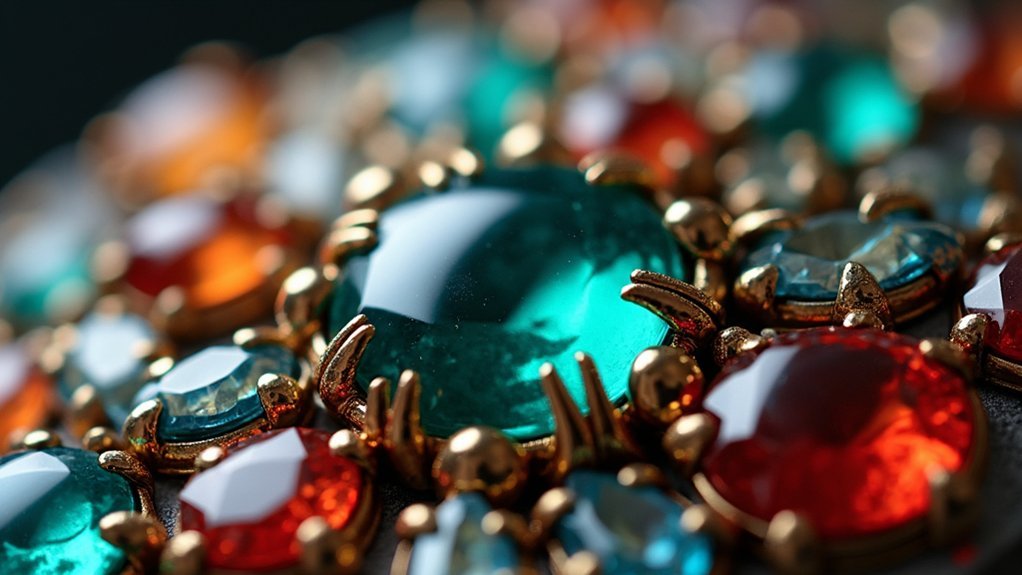You’ll master professional stone setting through three essential finishing techniques. First, use traditional round pointed or flat tip burnishers to compress metal securely around stones, creating tight holds with multiple test fittings. Second, employ polishing methods using flex shafts or Dremels to remove tool marks and enhance brilliance without damaging settings. Third, select proper tools including cutting burs, pumice wheels, and finishing media for flawless results. These foundational methods will elevate your jewelry craftsmanship considerably.
Burnishing Methods for Secure Stone Placement

When you’re working with flush and bead settings, burnishing methods offer one of the most reliable ways to secure stones by using specialized tools to compress the surrounding metal over the stone’s edges.
You’ll need traditional round pointed or flat tip burnishers that match your stone’s size for ideal effectiveness in stone setting.
Proper burnishing requires multiple test fittings to achieve precise adjustments and a snug fit. As you compress the metal, you’re not only creating a tight hold but also working to enhance aesthetic appeal through smooth, polished edges around the stone.
Burnishing compresses metal around stones, creating both secure settings and polished, professional-looking edges that enhance the piece’s overall aesthetic appeal.
The key to success lies in selecting the right burnisher size, as this greatly affects your technique’s effectiveness.
When done correctly, you’ll secure stones while creating beautiful, professional-looking results.
Polishing Techniques to Enhance Stone Brilliance
Achieving maximum stone brilliance requires mastering specific polishing techniques that transform your carefully set stones into dazzling focal points.
You’ll get exceptional results using a flex shaft or Dremel for precise control when polishing around delicate areas. These tools help remove tool marks left during setting stones without damaging your work.
For bezel setting, run a pumice wheel along edges to create smooth surfaces that enhance the stone’s appearance.
When working on pave setting, protect surrounding metal with denim pieces to prevent scratches during polishing.
Consider tumbling your finished pieces for twelve hours with specialized medium like Hone and Highlight, which creates stunning matte shimmer effects on oxidized silver while ensuring even polish distribution across your entire setting.
Professional Tool Selection for Flawless Finishes

Four essential tool categories will determine whether your stone settings achieve professional-grade finishes or fall short of expectations. Your flex shaft serves as the backbone for precision work, while setting bur types refine specific details for perfect stone placement. Even though many jewelers overlook finishing mediums, they’re vital for achieving that coveted professional polish.
| Tool Category | Primary Function | Recommended Types |
|---|---|---|
| Rotary Tools | Precision polishing | Flex shaft, Dremel |
| Cutting Burs | Detail refinement | Ball bur, Setting bur |
| Finishing Media | Surface smoothing | Pumice wheel, Hone & Highlight |
| Protection | Damage prevention | Denim pieces |
| Drill Components | Channel setting prep | Various drill bits |
Channel setting requires drill bits used to hold stones securely. Regular tool cleaning prevents contamination, ensuring consistent results across all your finishing work.
Frequently Asked Questions
What Is the Best Stone Setting?
You’ll find that prong settings work best for diamonds since they maximize brilliance, while bezel settings protect fragile stones like opals. Choose channel settings for multiple stones requiring seamless protection.
What Is the Most Secure Stone Setting?
You’ll find the bezel setting offers maximum security for your gemstones. It wraps a thin metal strip completely around the stone’s edges, protecting them from damage while providing an incredibly sturdy grip that won’t loosen.
How Do I Make My Gemstones Shiny Again?
You’ll restore your gemstones’ shine by cleaning them with warm soapy water and a soft brush, then using a jewelry polishing cloth. Rinse thoroughly and dry with a lint-free cloth afterward.
What Is the Difference Between Gypsy and Bezel Setting?
You’ll find gypsy setting places stones flush with metal’s surface for sleek looks, while bezel setting wraps thin metal around stone edges, providing more protection and creating bold frames that highlight your gemstone’s features.
In Summary
You’ve now mastered the three essential stone setting finishing techniques that’ll take your jewelry work to the next level. By implementing proper burnishing methods, you’ll guarantee your stones stay securely in place for years to come. The polishing techniques you’ve learned will maximize each stone’s natural brilliance and fire. With the right professional tools in your workshop, you’ll consistently achieve those flawless finishes that distinguish expert craftspeople from amateurs.





Leave a Reply